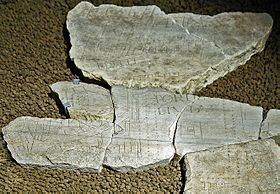 | ||
Similar Santa Lucia in Selci, The Seven Halls, Porta Esquilina, Saepta Julia, Baths of Titus | ||
The Portico of Livia (Latin: porticus Liviae) was a portico in Regio III Isis et Serapis of ancient Rome. It was built by Augustus in honour of his wife Livia Drusilla.
In 15 BC Augustus ordered the construction of a portico to be built onto the house of Publius Vedius Pollio, a rich freedman and one of his advisors, who had left the house to Augustus. Work was completed in 7 BC, when the complex was completed and granted to Livia and her son Tiberius on the occasion of his triumph. The portico was on the northern side of the Oppian Hill, to the south of the clivus Suburanus, in an area between that street and a space later occupied by the back of the Baths of Trajan.
Its plan survives in three fragments of the Forma Urbis Romae (10, 11, 109). It was rectangular, 115 m long by 75 m wide, with an external wall and a double row of columns inside. Each of the long sides had two semicircular and one rectangular niche. A semicircular apse opened off the south side, with a 20 m wide staircase to the clivus Suburanus. At its centre was a structure which may have been a fountain or the Altar of Concord built by Livia. The portico was magnificent and popular and became the most important site in the city after the Campus Martius. It was mentioned in the Notitia (Regio III).
In 1984 excavations have unearthed the remains of the pre- and post-Augustan floor levels - the portico was still in use in the 5th century but in the 6th century it was used for burials.
